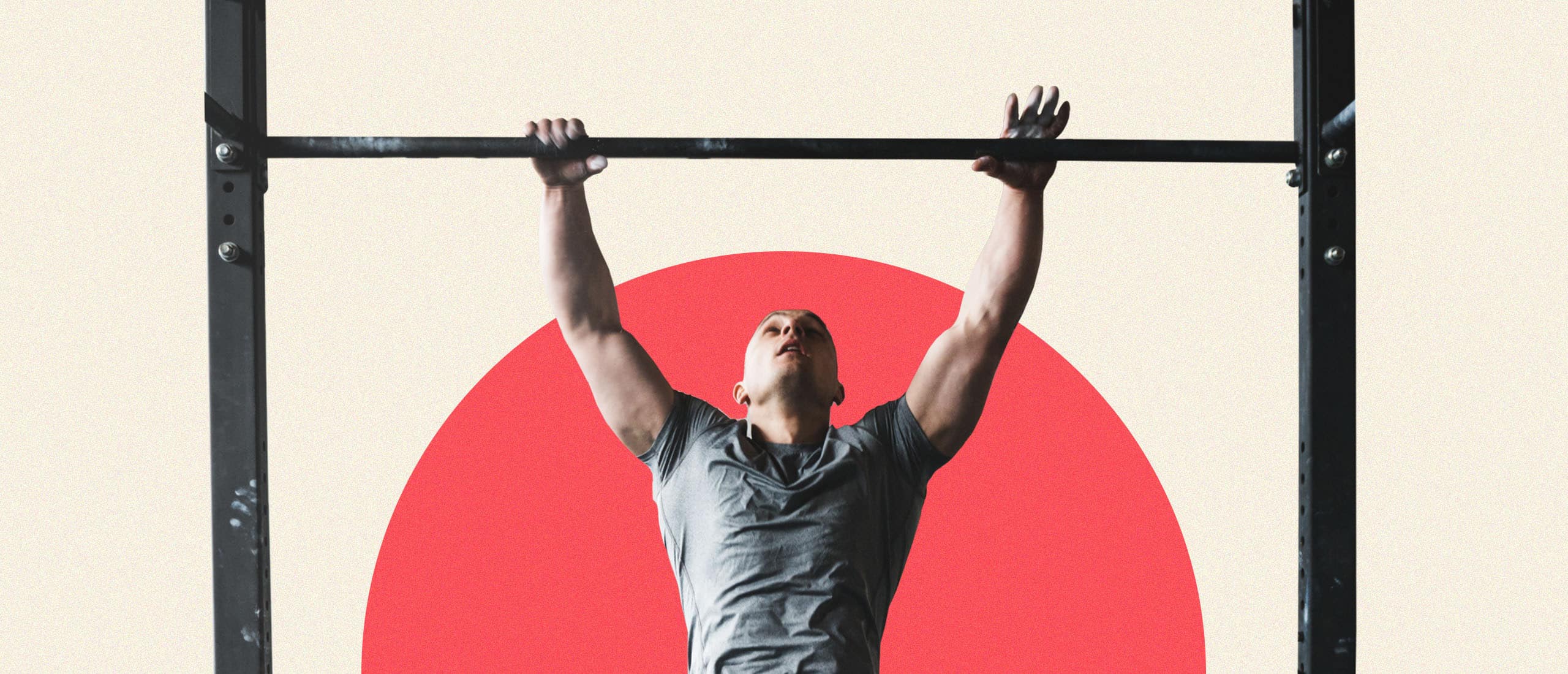This Simple Bodyweight Exercise Can Help You Live Longer and Lift Heavier
The more complex an exercise, the better. Right? Not always. Case in point: the dead hang. A dead hang is exactly what it sounds like: hanging from a pull-up bar with both hands. Yes, it’s that simple. While dead hangs are seemingly basic, the benefits are anything but. Hanging can increase grip strength, improve your posture, upgrade shoulder health, and might help you live longer. Here are the surprising benefits of dead hangs, exactly how to do them, and dead hang variations to take your functional fitness to the next level.
What Are Dead Hangs?
The dead hang is an exercise that involves gripping an overhead pull-up bar to support your hanging body, with arms fully extended and feet off the ground. Unlike pull-ups or chin-ups, you don’t have to lift your body up and over the bar. Instead, the dead hang is an isometric exercise (AKA a static hold for time) where you don’t actually move, but rather muscles like your core and shoulders work to keep your body stable as you hang.
How To Do a Dead Hang
First, make sure you have a secure, wide, and sturdy pull-up bar you can hold onto. Ideally, the bar should be high enough so that you can’t touch your feet to the ground while hanging with arms extended from the bar. Once you’ve got the setup down, here’s how to do it:
- Use an overhand grip (with palms facing away from you) to grab onto a secure overhead pull-up bar with hands about shoulder-width apart. Avoid jumping to grab onto the bar as gaining control of your swinging body can add an extra layer of challenge. Instead, place a step, bench, or box underneath the bar if you need a lift.
- If using a step, bench, or box, step off so you’re hanging onto the bar with your arms fully extended, and body hanging below. If the bar is low enough that your feet are touching the ground, bend your knees to bring your shins and feet behind your body.
- Try to keep your upper body relaxed, with your arms straight (no elbow bend), but engage your core, glutes, and shoulders for stability.
- Hold for 10 to 30 seconds, working up to 90 seconds with practice.
Dead Hang Benefits
Doing dead hangs comes with a laundry list of perks. These are the highlights.
Strengthens upper body
Dead hangs are proof that you don’t need to lift heavy to build strength. As you hang, you’ll work most of the muscles in your back, arms, and core, including:
- Shoulders: deltoids and rotator cuff muscles
- Abs and Obliques: rectus abdominis, transverse abdominis, and internal and external obliques
- Upper back: trapezius, rhomboids
- Back: latissimus dorsi and erector spinae
- Arms: biceps and triceps
- Forearms: brachioradialis and other hand and wrist flexors
Improves grip strength
While dead hangs put the majority of your upper body to work they lean most heavily on your forearm muscles—which, in turn, helps to strengthen your grip. A strong grip is essential: you use it daily. When you pick up a box, move a chair, vacuum, cook, or even drive, you’re calling on your grip strength. It’s also one of the quickest ways to bigger lifts, building muscle, and serious training gains.
Grip strength is considered a solid proxy for overall body strength and muscle mass (both of which decrease as we age) (1). A weak grip has been linked to a higher risk of cardiovascular disease, stroke, myocardial infarction, diabetes, high blood pressure, and all-cause mortality (2, 3). Poor grip strength may also age your body faster. The weaker your grip strength, the older your biological age, per a study published in the Journal of Cachexia, Sarcopenia, and Muscle (4).
Decompresses spine
Sitting at a desk all day or doing heavy structural exercises that load up your axial spine (like back squats) compresses your spine, which can contribute to back pain. Thanks to gravity, dead hangs can help open up the spine, increasing the space between your vertebrae and allowing oxygen and nutrient-rich fluid to rehydrate your discs.
Hanging also provides a nice little stretch to muscles that commonly get tight with poor posture, like your lats. For example, if you identify as a chronic sloucher, your lats tend to get tight which can restrict your functional range of motion during exercise and everyday tasks, and can manifest as an annoying, ongoing upper back ache.
Corrects posture
Dead hangs are a double whammy for better posture. They stretch muscles like your lats, which can get tight thanks to chronically hunched posture. Dead hangs can also help to strengthen key postural muscles like your core, erector spinae, and shoulders—which provide stability and support proper movement.
Improves mobility
Tight lats restrict your shoulder and upper-back mobility which limits your ability to reach overhead, sabotaging your strength and potentially putting your back in a dangerous position during overhead movements. Mobility is a joint’s ability to move through its range of motion, which requires both flexibility and strength. Because the dead hang both stretches and strengthens your lat through a lengthened position, it improves mobility, allowing you to move better.
Boosts shoulder stability
By regularly incorporating dead hangs into your workout routine, you’ll strengthen your scapular muscles—the muscles that surround your shoulder blade and attach to the shoulder and upper arm. Strengthening these muscles can keep your shoulder joint stable, which is essential for safely completing overhead movements, whether you’re putting a carry-on suitcase in an overhead airplane bin or doing a heavy overhead press.
Helps you progress to a pull-up
The dead hang is the starting point of a single pull-up and your resting point in between reps. If your current fitness goal is to rep out pull-ups like it’s no big deal, mastering dead hangs is the first step to getting there. Once you can hold the position for 30 seconds, practice scap pull-ups as your next step. Scap pull-ups are basically a dead hang where you alternate between pulling shoulders down and back and relaxing in a dead hang.
Dead Hang Variations
Once you’ve got your dead hang down try different grips like underhand (palms facing towards you), neutral (palms facing each other), or a single-handed grip. Or try to dead hang on overhead rings. Since rings aren’t as stable as a bar, you’ll have to fight to maintain stability.











